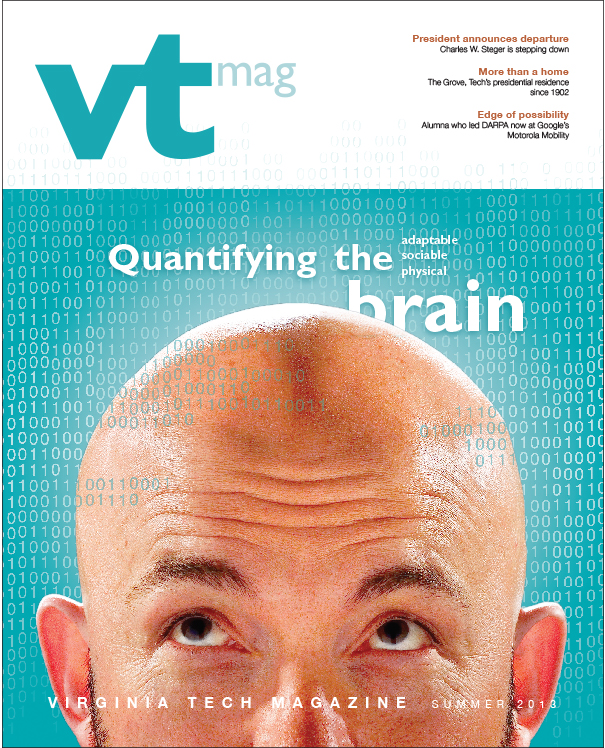Virginia Tech Magazine showcases brain research, the president's residence, Hokie license plate programs

In a rich slate of feature stories, faculty and alumni profiles, and university news and research of note, the summer 2013 edition of Virginia Tech Magazine explores the university's cutting-edge brain research, the unique history of its presidential residence, and the popular license plate program that funds scholarships.
Virginia Tech President Charles W. Steger announces in his magazine column his intention to step down after 14 years leading the university. Steger, who will remain in office until his successor has begun work, has been widely commended for his visionary leadership in transforming Virginia Tech into one of the country's top research institutions.
Several research teams in high-powered labs at the Virginia Tech Carilion Research Institute, now in its third year, are dedicated to studying the brain: its influence on all aspects of our bodies and our behavior, its adaptive capabilities, and, in certain instances, its potential for training and retraining. Often mind-blowing, the teams' findings have garnered considerable attention for the Roanoke-based institute and its researchers.
Home to all but one of Virginia Tech's presidents since 1902, The Grove has a colorful past that includes lawn-grazing sheep and flying ducks — along with the more customary dinner parties and distinguished quests. Having undergone major renovations over the years, the residence helped establish a tradition of elegant hospitality that has served the university well.
Virginia Tech license plates are available in Delaware, Maryland, North Carolina, Pennsylvania, Tennessee, Texas, Virginia, and West Virginia, where local Alumni Association chapters often use the specialty plates to raise money for scholarships for current students from their areas. Since fiscal year 2000, the Commonwealth of Virginia alone has distributed $2.63 million in revenue to Virginia Tech. In particular, the funding benefits students through the University Honors program and the Presidential Campus Enrichment Grant.
The magazine's fifth installment in its series on the burgeoning tech sector and economic growth in the Roanoke and New River valleys features Virginia Tech alumna Mary Guy Miller, founder and president of Interactive Design and Development Inc., a full-service digital agency. A past president of the Roanoke Blacksburg Technology Council, Miller emphasizes the role of mentors in cultivating a thriving community of startups and innovation.
An alumna profile examines the remarkable career of Regina Dugan, now senior vice president of Motorola Mobility's Advanced Technology and Projects group. Long recognized for her renegade creativity, Dugan, who earned bachelor's and master's degrees in mechanical engineering from Tech, is a former program manager and director at the Defense Advanced Research Projects Agency and also served in executive roles in several commercial companies.
And in the latest installment of How Tech Ticks, the steps taken to clone the beloved sycamore that once graced Henderson Lawn are explained by professors John Seiler and Eric Wiseman of the College of Natural Resources and Environment. Produced by a practice known as vegetative propagation, a cloned version of the beloved tree was planted on Henderson Lawn on April 22 in celebration of Earth Day.
The Web version of Virginia Tech Magazine features online-only multimedia content. Request hard copies by emailing Jesse Tuel, magazine editor.
Dedicated to its motto, Ut Prosim (That I May Serve), Virginia Tech takes a hands-on, engaging approach to education, preparing scholars to be leaders in their fields and communities. As the commonwealth’s most comprehensive university and its leading research institution, Virginia Tech offers 240 undergraduate and graduate degree programs to more than 31,000 students and manages a research portfolio of $513 million. The university fulfills its land-grant mission of transforming knowledge to practice through technological leadership and by fueling economic growth and job creation locally, regionally, and across Virginia.












.jpg.transform/m-medium/image.jpg)
